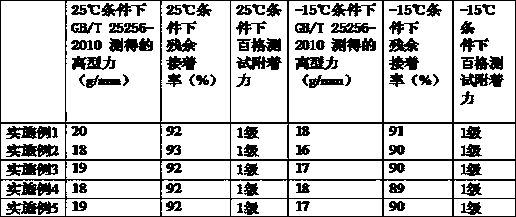Light peeling-type release agent and preparation method thereof
A release agent and light release technology, which is applied in the direction of textiles and papermaking, fiber raw material processing, paper coating, etc., can solve the problems of affecting the use of tapes, unstable performance, poor weather resistance, etc., to reduce transfer rate and improve coating Covering ductility and uniformity, and the effect of improving weather resistance
- Summary
- Abstract
- Description
- Claims
- Application Information
AI Technical Summary
Problems solved by technology
Method used
Image
Examples
Embodiment 1
[0026] Embodiment 1: a kind of release agent of light release force, described release agent is obtained by the component of following parts by weight:
[0027] 100 parts of pre-polymerized resin,
[0028] 0.6 parts of methyl hydroquinone,
[0029] 12 parts of 2-hydroxymethyl oxetane,
[0030] 25 parts of dodecyl glycidyl ether,
[0031] 3.2 parts of 1-hydroxycyclohexyl benzophenone.
[0032] Described prepolymerized resin is obtained by following steps:
[0033] Step 1. Put 45 parts of cyclohexyl methacrylate, 20 parts of β-carboxyethyl acrylate, and 10 parts of urethane (meth)acrylate into a mixing tank, and stir at a low speed to form a primary mixture;
[0034] Step 2, mix the primary mixture of step 1, 100 parts of xylene, and 0.3 parts of benzoyl peroxide, and then add them to the reaction kettle, stir and react at a medium speed for half an hour, and then stand still for 1 to 2 hours to obtain a polymer solution; The temperature of the reactor in the step 2 is 75°C...
Embodiment 2
[0038] Embodiment 2: a kind of release agent of light release force, described release agent is obtained by the component of following parts by weight:
[0039] 100 parts of pre-polymerized resin,
[0040] 0.9 parts of methyl hydroquinone,
[0041] 15 parts of 2-hydroxymethyl oxetane,
[0042] 22 parts of dodecyl glycidyl ether,
[0043] 4 parts of 1-hydroxycyclohexyl benzophenone.
[0044] Described prepolymerized resin is obtained by following steps:
[0045] Step 1. Put 48 parts of cyclohexyl methacrylate, 25 parts of β-carboxyethyl acrylate, and 12 parts of urethane (meth)acrylate into a mixing tank, and stir at a low speed to form a primary mixture;
[0046] Step 2, mix the primary mixture of step 1, 100 parts of xylene, and 0.32 parts of benzoyl peroxide, and then add them to the reaction kettle, stir and react at a medium speed for half an hour, then let stand for 1 to 2 hours to obtain a polymer solution; The temperature of the reactor in the step 2 is 72°C;
[0...
Embodiment 3
[0050] Embodiment 3: a kind of release agent of light release force, described release agent is obtained by the component of following parts by weight:
[0051] 100 parts of pre-polymerized resin,
[0052] 0.6 parts of methyl hydroquinone,
[0053] 18 parts of 2-hydroxymethyl oxetane,
[0054] 28 parts of dodecyl glycidyl ether,
[0055] 4.2 parts of 1-hydroxycyclohexyl benzophenone.
[0056] Described prepolymerized resin is obtained by following steps:
[0057] Step 1. Put 42 parts of cyclohexyl methacrylate, 16 parts of β-carboxyethyl acrylate, and 14 parts of urethane (meth)acrylate into a mixing tank, and stir at a low speed to form a primary mixture;
[0058] Step 2, mix the primary mixture of step 1, 100 parts of xylene, and 0.25 parts of benzoyl peroxide, and then add them to the reaction kettle, stir and react at a medium speed for half an hour, and then stand still for 1 to 2 hours to obtain a polymer solution; The temperature of the reactor in the step 2 is 72°...
PUM
 Login to View More
Login to View More Abstract
Description
Claims
Application Information
 Login to View More
Login to View More - Generate Ideas
- Intellectual Property
- Life Sciences
- Materials
- Tech Scout
- Unparalleled Data Quality
- Higher Quality Content
- 60% Fewer Hallucinations
Browse by: Latest US Patents, China's latest patents, Technical Efficacy Thesaurus, Application Domain, Technology Topic, Popular Technical Reports.
© 2025 PatSnap. All rights reserved.Legal|Privacy policy|Modern Slavery Act Transparency Statement|Sitemap|About US| Contact US: help@patsnap.com

